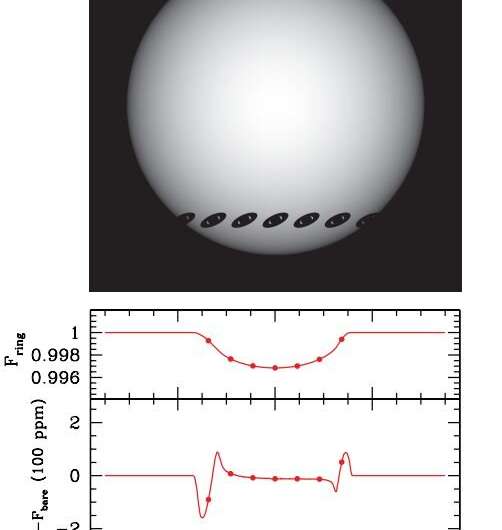December 5, 2019 report
Evidence suggests some super-puffs might be ringed exoplanets

A pair of researchers from the Observatories of the Carnegie Institution for Science and the California Institute of Technology have reported evidence that some super-puff exoplanets might be ringed exoplanets. Anthony Piro and Shreyas Vissapragada have written a paper describing their theory and the evidence supporting it and have posted it on the arXiv preprint server.
As Piro and Vissapragada note, space scientists have found a host of exoplanets in recent years with a wide range of attributes. One such group is called "super-puffs," because they have very large radii for their masses, and thus very low densities. Such exoplanets seem to have exceptionally extended atmospheres without explanation. What scientists find odd about them is that that they do not seem to be susceptible to photoevaporation. Piro and Vissapragada suggest that this is because they do not have extended atmospheres at all; instead, they have rings like Saturn.
The researchers report that they came to their theory when considering what Saturn would look like to space scientists from a distant world if they did not know about the rings—they found it likely that such aliens would likely see the planet as having just half of its true density. That got them to wondering if some discovered exoplanets, such as super-puffs, might have miscalculated densities due to orbital rings.
The researchers started by considering possible attributes of an exoplanet with rings. They noted that exoplanets close to their star would have rocky rings, because ice would melt. Also, some of the exoplanets would not be able to form rings wide enough to change density estimations due to distant rocks likely clumping, forming moons. Next, they used their assumptions to create simulations that showed what ringed planets might look like to us as they pass across their star. They report that their simulations showed that some of the super-puffs could be ringed exoplanets. They suggest that new data from the James Webb Space Telescope, set for launch in 2012, might confirm their theory.
More information: Exploring Whether Super-Puffs Can Be Explained as Ringed Exoplanets, arXiv:1911.09673 [astro-ph.EP] arxiv.org/abs/1911.09673v1
© 2019 Science X Network





















